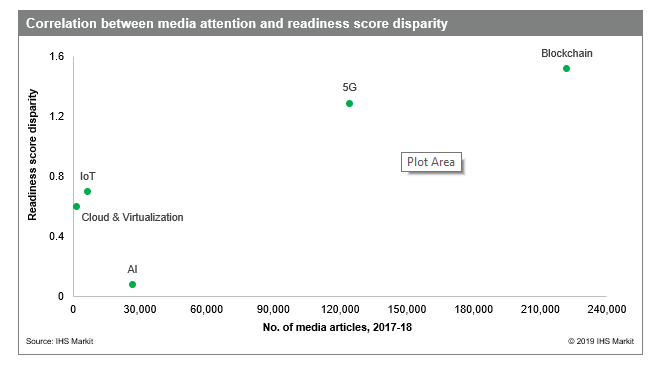In researching the role and impact of six transformative
technologies in key industries today, Digital Orbit utilized two
focus groups. A collective of IHS Markit analysts formed one of the
groups in question, while the other group consisted of respondents
from Digital Orbit’s Key Influencer Survey—an appraisal of
leaders and major decision-makers at companies in industries where
these technologies are being implemented.
While these two groups had similar thoughts in many aspects of
transformative technologies, there were some disparities in their
views. One metric in dispute was the readiness of these
technologies to be widely adopted by industry.
Overall, the survey respondents judged the readiness of industry
in adopting transformative technologies to be higher, with a
cumulative score of 4.8. In comparison, the IHS Markit analyst
collective gave the metric a much lower score of 3.9.
An external factor revealed
The disparity could be attributed to various factors, including
the background of the respondents and their experience with
technology. The Key Influencer respondents<span/> came from six big industries where the
effects of transformative technologies were being monitored by
Digital Orbit. Those six industries included automotive,
manufacturing, healthcare, telecommunications, energy, and
consumer.
After further study and analysis, however, it became
increasingly possible that the disparity in readiness scores
between Digital Orbit’s two focus groups could be attributed to the
workings of an external factor—one that had no direct contact
with the surveys or research being undertaken in Digital Orbit, and
yet possessed a significance and impact that could not be
overlooked.
That external—and previously unaccountable—factor turned
out to be the media, whose coverage of transformative technologies
has been intense and unrelenting. In fact, an IHS Markit review of
a select number of general-interest websites in 2018 found nearly
250,000 articles that either mentioned or discussed at length at
least one of Digital Orbit’s five transformative
technologies—Video Everywhere had not yet been included in the
study at that time.
That remarkable figure meant that on average, approximately 750
articles on transformative technologies had appeared in the media
every day for the entire year in 2018.
The potential negative effects of extreme coverage
Such intense scrutiny can cut both ways. While in-depth
reporting is useful in raising public awareness of a subject or
even fostering innovation in some cases, the hard glare of media
can also produce a negative outcome, especially when coverage
becomes skewed toward publicity or propaganda—the so-called
“hype” machine at work. And without sufficient care taken during
reporting, bias or the advocacy of a specific line of thinking
could easily creep in, potentially giving rise to damaging
misconceptions, unrealistic expectations, or outright false
ideas.
All told, the vast amount of media attention on today’s emerging
technologies makes separating hype from reality difficult, even for
those with considerable background and experience in the area. And
a surfeit of media attention could understandably influence
expectations on a specific technology and its timing or impact.
To be sure, the relationship between the amount of press
attention and the readiness score obtained by a specific technology
in Digital Orbit is far from conclusive. And yet a review of the
discrepancies in 2018 between readiness scores given by IHS Markit
analysts and those delivered by respondents of the Key Influencer
Survey suggests there may be some correlation.

For instance, 5G and Blockchain, both of which racked up the
largest number of media articles in 2018, also had the highest
discrepancy in readiness scores between the analysts and the survey
respondents, as shown by the graphic above. This is an area that
Digital Orbit will examine further in future editions.
Josh Builta is senior principal analyst for transformative
technologies at IHS Markit
Posted 20 June 2019